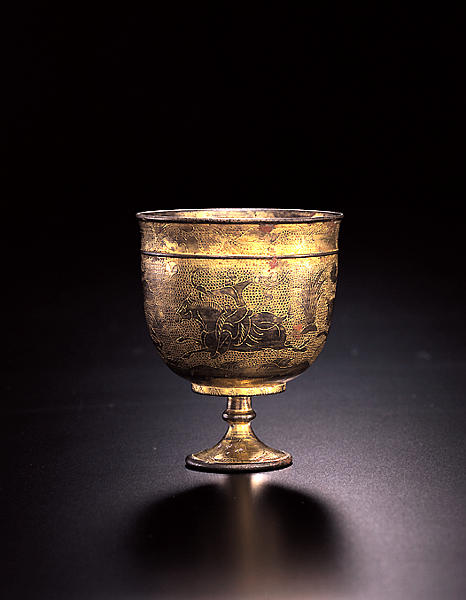Stem Cup with Hunting Scene
- China
- China, Tang period
- late 7th to 8th centuries
- Gilt bronze
- H-6.5 D-6
Catalogue Entry
Gold and silver vessels were cherished commodities in Tang-period China, and Persian Sasanian and Sogdian metal techniques and shapes blended with those popular during the Roman-Byzantine Empire to provide inspiration for Chinese metalworkers.1
Although several metal Roman-Byzantine stem cups have been unearthed in China at sites dating from the Northern Wei period (A.D. 386-534) and Sui dynasty (A.D. 581-618), similar cup forms, often with accompanying trays, were made in pottery in China during this time.2 It was not until the Tang period, when artistic influences from the Near East and Central Asia increased, that metal models were created by Chinese artisans. By then precious-metal stem cups were desired by the elite throughout China, and examples were painted onto tomb walls even in the northwestern province of Xinjiang. In addition, representations of the metal models were carved into the stone wall of a Tang-dynasty emperor's tomb just outside of Chang'an.3
The egg-shaped Shumei cup with a flared lip, complemented by a stem featuring a ringed area and a broad foot, was initially cast in bronze. A chased cloud pattern decorates the upper frieze of the cup rim.4 Below the frieze, on the surface of the body, is a scene featuring mounted hunters and animals (which is chiseled). This Near Eastern design, dating in the West as early as the sixth-fifth century B.C., is known as the "flying gallop" and appears on Tang-period textiles and tomb wall paintings, as well as on metal vessels.5 The cup's remaining exterior surface features a series of ring-matted designs. This piece has been stripped by time of its initial high-gloss, golden luster, acquiring instead a gilt honey-toned surface.
A silver cup patterned with similar designs was excavated from Hejia village, and another silver stem cup was found at Sha'po village near Xi'an.6 In the United States, the Asian Art Museum of San Francisco has a gilt bronze example that closely resembles the Shumei piece, as does the British Museum. The Carl Kempe collection has two silver stem cups similar in shape to the Shumei cup but patterned with floral scroll, grape, and leaf motifs.7
JMS
1. Kaogu 1994.2, pp. 174-83; Wenwu 1996.5, pp. 42-43.
2. Two stem cups were found at Datong: see Wenwu 1990.5, pp. 4-5. A Roman-Byzantine silver cup was also unearthed from a tomb dated 608 near Xi'an and belonging to Li Jingxun, whose ancestors held office in Hexi. Moreover, a tomb belonging to Li's great-grandfather, Li Xian of Northern Zhou (557-581), unearthed in Ningxia province contained a gilded silver ewer and a bowl thought to be Bactrian or Sasanian (Wenwu 1996.2, pp. 45-50). For examples of pottery stem cups with trays found at Jiangxi province and dating from the Six Dynasties period see Wenwu 1996.2, p. 43, fig. 14:1.
3. Mu, Qi, and Zhang 1994, p. 87, fig. 213; Wenwu 1996.5, p.36.
4. Technical information courtesy of Pieter Meyers and Richard H. Kimball.
5. Concerning the "flying gallop" motif in Persian art see Rostovtzeff 1937, pp. 44-56; Jaffe and Colombardo 1983, p. 187. Although Chinese artisans began to paint hunting scenes onto tomb walls during the fourth century (see Tongguo wall painting, Zhu Dongshou, Zhongguo bihua shigong, 1995, fig. 10), it is not clear if this theme was inspired by the Near East or had developed independently. By the Tang period, though, there is a definite Near Eastern influence. For Tang-period hunting scenes painted onto walls see Fontein and Tung 1976, pp. 92-93, figs. 111, 112. For a textile with the flying gallop motif see Five Thousand Years of Chinese Art Committee 1992, p. 66.
6. Li and Shen 1995, p. 9. See Zhenjiang bowuguan Shaanxi sheng bowuguan 1985, pl. 15, fig. 16, for the Sha'po village cup; pl. 56, fig. 57, for the Hejiacun cup. See also Kaogu 1994.1 p. 186, fig. 6; Xi'an Cultural Relics Supervising Committee 1964.6, pp. 30-32.
7. Fontein and Tung 1973, pp. 180-81; Gyllensvard 1953, pl. 109.
Catalogue Entry
The sides of this tall stem are decorated with a chased ground against which horseback pursue deer with half bows, and the attendants to the horseback hunters come towards them on horse back, driving the animals with catapult‐like weapons. The upper band of the torso is decorated with vining plant motifs and the area beneath the horsemen shows grass on land spits. The lower face of the torso is carved with a fretted pattern filled in with a chased design. The lower face of the cylindrical section shows a seven‐petal flower motif (though one of the petals has been beaten in twice, showing a graver's mistake). The upper section of the stem shows complex four‐petal flower motif with an inner layer of smaller petals. All of these patterns have been carved into the metal with a engraving tool.
The images here have been largely engraved into a linked set of somewhat elongated triangular panels, and there are some places where the graver tilted the engraving tool to create linear pattems.
The style of the images and the engraving techniques are gentle and have lost a bit of their sense of detail, which would seem to indicate that this cup is from the Late Tang, close in date and style to the Gold ewer with mandarin ducks and foliage scrolls (Xianyang Museum) excavated from the storing site at Xianyang, Shaanxi.
